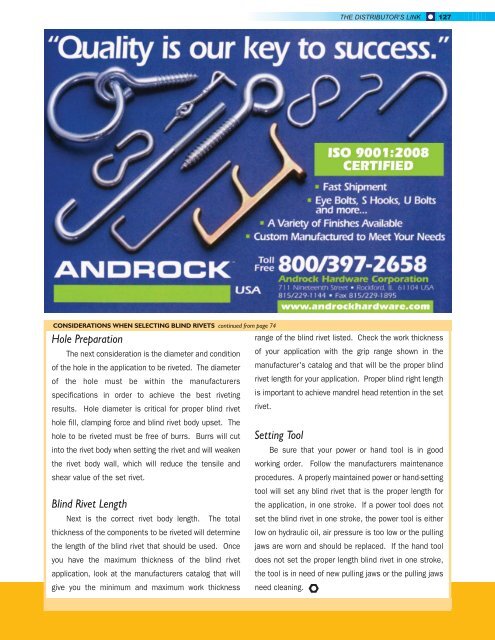SPRING 2012
Distributor's Link Magazine Spring Issue 2012 / VOL 35 / NO.2
Distributor's Link Magazine Spring Issue 2012 / VOL 35 / NO.2
You also want an ePaper? Increase the reach of your titles
YUMPU automatically turns print PDFs into web optimized ePapers that Google loves.
THE DISTRIBUTOR’S LINK 127<br />
CONSIDERATIONS WHEN SELECTING BLIND RIVETS continued from page 74<br />
Hole Preparation<br />
The next consideration is the diameter and condition<br />
of the hole in the application to be riveted. The diameter<br />
of the hole must be within the manufacturers<br />
specifications in order to achieve the best riveting<br />
results. Hole diameter is critical for proper blind rivet<br />
hole fill, clamping force and blind rivet body upset. The<br />
hole to be riveted must be free of burrs. Burrs will cut<br />
into the rivet body when setting the rivet and will weaken<br />
the rivet body wall, which will reduce the tensile and<br />
shear value of the set rivet.<br />
Blind Rivet Length<br />
Next is the correct rivet body length. The total<br />
thickness of the components to be riveted will determine<br />
the length of the blind rivet that should be used. Once<br />
you have the maximum thickness of the blind rivet<br />
application, look at the manufacturers catalog that will<br />
give you the minimum and maximum work thickness<br />
range of the blind rivet listed. Check the work thickness<br />
of your application with the grip range shown in the<br />
manufacturer's catalog and that will be the proper blind<br />
rivet length for your application. Proper blind right length<br />
is important to achieve mandrel head retention in the set<br />
rivet.<br />
Setting Tool<br />
Be sure that your power or hand tool is in good<br />
working order. Follow the manufacturers maintenance<br />
procedures. A properly maintained power or hand-setting<br />
tool will set any blind rivet that is the proper length for<br />
the application, in one stroke. If a power tool does not<br />
set the blind rivet in one stroke, the power tool is either<br />
low on hydraulic oil, air pressure is too low or the pulling<br />
jaws are worn and should be replaced. If the hand tool<br />
does not set the proper length blind rivet in one stroke,<br />
the tool is in need of new pulling jaws or the pulling jaws<br />
need cleaning.

















